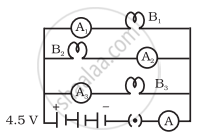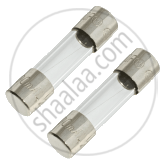Advertisements
Advertisements
प्रश्न
B1, B2 and B3 are three identical bulbs connected as shown in Figure. When all the three bulbs glow, a current of 3A is recorded by the ammeter A.
- What happens to the glow of the other two bulbs when the bulb B1 gets fused?
- What happens to the reading of A1, A2, A3 and A when the bulb B2 gets fused?
- How much power is dissipated in the circuit when all the three bulbs glow together?

उत्तर
Since all the three bulbs are identical so current through each bulb will remain same i.e 1 A
- Even when bulb B1 gets fused, other two bulbs will continue to glow with same brightness because all the three bulbs are connected in parallel so potential difference across each bulb remains same.
- When bulb B2 gets fused then the reading A2 will become zero. The reading of A1 and A3 will remain same as 1 A because potential difference across them remains same. However, the reading of A will decrease and will become 2 A.
- Power dissipated by bulb B1 will be
P1 = VI
P1 = 4.5 × 1
P1 = 4.5 W
Similarly,
P2 = 4.5 W
P3 = 4.5 W
Hence total power dissipated by the circuit will be
Pnet = P1 + P2 + P3
Pnet = 4.5 + 4.5 + 4.5
Pnet = 13.5W
APPEARS IN
संबंधित प्रश्न
Why is a series arrangement not used for connecting domestic electrical appliances in a circuit?
A heating coil has a resistance of 200 Ω. At what rate will heat be produced in it when a current of 2.5 A flows through it?
Give a scientific reason.
For electric power transmission, copper or aluminium wire is used.
Identify the figure and give its use.

Which of the following substance contracts on heating?
What is the heating effect of electric current?
Which metal is used to make the filament of an electric bulb?
What does overloading cause?
It would cost a man Rs. 3.50 to buy 1.0 kW h of electrical energy from the Main Electricity Board. His generator has a maximum power of 2.0 kW. The generator produces energy at this maximum power for 3 hours. Calculate how much it would cost to buy the same amount of energy from the Main Electricity Board.
A student boils water in an electric kettle for 20 minutes. Using the same mains supply he wants to reduce the boiling time of water. To do so should he increase or decrease the length of the heating element? Justify your answer.
